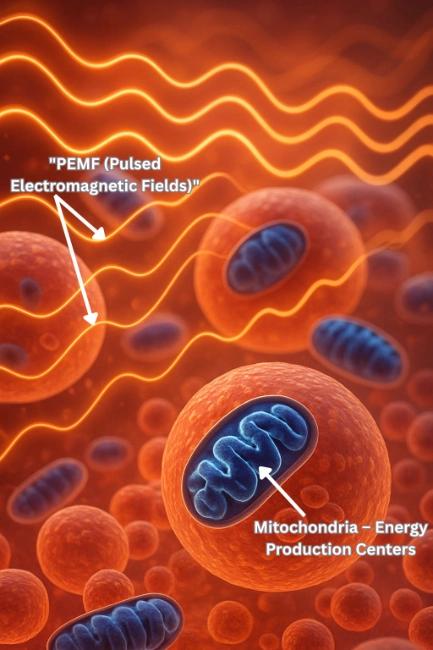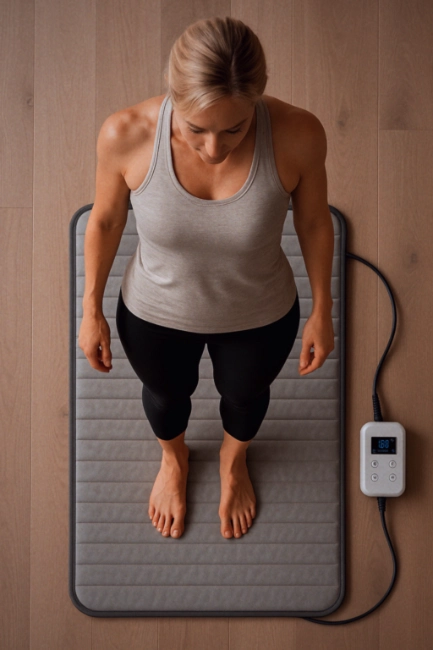Are PEMF Mats Safe? Risks, Results, and Research

A Research Driven Look at Risks, Results, and What to Know Before You Try.
You’ve seen the promises. Less pain. Deeper sleep. Faster recovery. A mat you lie on that somehow energizes your cells and resets your body?
PEMF mats, (short for Pulsed Electromagnetic Field therapy mats) are slowly gaining traction as a staple wellness/ recovery tool. They farewell known by people who are serious about feeling better and recovering smarter. But a question that comes up a lot (and rightly so) is this: are PEMF mats safe?
That’s by no means a paranoid question. It’s a smart one. When something is claiming to heal your body using electromagnetic fields, you deserve more than buzzwords! You want to know what it actually does, what the risks are, and whether it’s legitimate or just another expensive gadget that will eventually gather dust in your closet. All this is especially true if you’ve already been wondering: does PEMF therapy really work ?... and now want to understand both the safety and effectiveness sides.
So instead of giving you vague yes/no answers or salesy hype, we’re diving into what the research really says. We’ve also gathered honest user feedback and real-world safety data. The goal here isn’t to scare you off or convince you to buy something. We want to give you the kind of clarity that helps you make a smart, confident decision.
Let’s start with science ( don’t worry, we’ll keep it human).
Is PEMF Therapy Safe? What the Research Actually Says
There’s a surprising amount of research on PEMF therapy. We’re talking over 10,000 published studies in total, with thousands of them using gold-standard designs like placebo-controlled trials. But most people don’t have time to dig through PubMed or decipher what all those numbers actually mean. So here’s the short version, explained in real-world terms.
In a recent 2025 multi-center clinical trial on Evaluating Noninvasive Pulsed Electromagnetic Field Therapy , doctors tracked 120 people dealing with joint and soft tissue pain. Half used a PEMF device, and half followed standard care. The results? Pain dropped by 36% in the PEMF group (compared to just 10% with standard treatment), and more than half of them needed less medication. Here is kicker? Only 4 people had mild side effects from the PEMF therapy. And all they experienced was a little tingling or minor discomfort. None of it was serious.
A separate 2025 systematic review on the effectiveness of pulsed electromagnetic field therapy took things a step further. Instead of looking at one study, it combined data from several trials on people with shoulder issues. These were high-quality studies, meaning they weren’t just case reports or random anecdotes. The takeaway from them? People experienced measurable pain relief and functional improvement. The side effects were again, rare and mild, usually resolving within a day.
And if you’re wondering whether these results hold up in more common conditions, like arthritis? A 2024 review on pulsed electromagnetic fields looked at nearly 1,200 patients across 17 trials. The outcome: a 60% drop in pain on average, and clear improvements in how well people could move and function. It’s also worth to note, this wasn’t tied to one brand or one treatment protocol. It worked across a variety of devices and use cases.
In plain English?... Most people tolerate PEMF therapy really well. The risks are low, and the benefits for pain and recovery can be significant if the therapy is used consistently and correctly.
What Are the Side Effects of PEMF Mats (and Are They Serious?)
Let’s be real. Even the safest tools can come with side effects. PEMF therapy is no different. Though most of the effects people report tend to be mild and temporary.
Some users feel fatigued or extra sleepy after a session. That might sound like a red flag right out the gate, but it’s often a sign your nervous system is shifting into a relaxed, parasympathetic state. Basically, your body calming down and getting ready to repair.
Others mention mild headaches or a slightly nauseous feeling. This is mostly common during early use. Once again, this is likely your body adjusting to changes in circulation or detox responses. It usually fades away fast.
You might also notice tingling, warmth, or skin sensitivity around the site where it is used.. These sensations aren’t unusual and typically go away within minutes.
A few users describe a temporary flare up in pain. This usually only happens if they’re using PEMF for a chronic issue. This can be frustrating, but its best if viewed it as part of the healing process. A sign that the therapy is stimulating deeper biological change. Think of it like feeling sore after physical therapy. You feel uncomfortable, but sometimes that’s necessary.
On the flip side, some people feel nothing at all. (This was me during the first few sessions). One common complaint? “I’m not feeling anything… is it working?”. PEMF doesn’t always give you an obvious sensation. We know… this can be disappointing if you're expecting a sudden jolt of energy or instant relief. Especially when doing PEMF therapy at home, where there's no professional to guide you with dosing. This can make it even more tricky to know if it’s doing anything.
Who Should Not Use PEMF Therapy?
Even with its strong safety record, PEMF therapy isn’t for everyone.
If you have a pacemaker or any other implanted electronic device, skip it. Seriously. PEMF can interfere with these devices, and the risk simply isn’t worth it.
Pregnant? This therapy hasn’t been studied enough during pregnancy to be considered safe. Itt’s best to avoid it unless your doctor specifically recommends otherwise.
There are also other conditions where PEMF could be a bit problematic:
If you’re dealing with active bleeding disorders, PEMF’s circulation boosting meaning it’s effects could worsen symptoms.
If you’ve had an organ transplant, electromagnetic stimulation could interfere with medications or healing.
People with epilepsy or a history of seizures should consult their neurologist before event trying PEMF, just to be safe.
Same goes for those with active cancer, hyperthyroidism, or children still in their growth phases. These groups require medical clearance.
In short: if your body is in a complex medical state or undergoing treatment, don’t guess. Get professional advice first.
PEMF Safety vs. Benefits. Is It Worth It for Recovery and Longevity?
This is where it can get personal. What are you hoping PEMF will actually do for you?
For some, it’s about finding relief from chronic pain (especially when they haven’t responded to meds, physical therapy, or supplements). Others use it post workout to reduce soreness and improve sleep quality (We’re in this camp right now). And there’s a growing group curious about its potential for long-term cellular repair and anti-aging benefits.
What’s the upside? It’s non-invasive, drug-free, and (for most people) pretty safe to use daily. And studies back that up. In the systematic review on osteoarthritis we mentioned earlier, users not only reported less pain, but also better movement and day to day function.
But here’s the reality check: The results can vary. What works wonders for one person may do very little for someone else. Some people feel a change in a few days. Others need weeks or months of consistent use to notice a difference.
And then there’s the price tag! Quality mats can run you $1,000 - $5,000+. There are budget options out there, but they’re often underpowered and honestly, poorly made. Some people even start by renting or booking professional sessions to give it a trial run. Not a bad idea. Realistically, it’s a low-risk way to test whether it’s worth fully investing.
If you’re exploring other recovery tech too, you might also compare it with tools like compression boots for circulation, which offer a more immediate, physical sensation. Or you might want to look into the difference between a PEMF mat vs grounding mat if you’re unsure what kind of “energy based” therapy suits your needs.
Conclusion: Is PEMF Therapy Safe and Worth Trying?
At the end of the day, PEMF therapy checks a lot of boxes. It’s low risk, minimal side effects, and growing clinical support for a range of issues like pain, inflammation, and recovery.
But like anything in the wellness space, it’s not a miracle device. It works best when:
You use it consistently, not just here and there
You give it time. Most benefits build slowly over weeks, not days
You pair it with other healthy habits like hydration, sleep, and movement
If that sounds like your approach already, PEMF therapy could be an great addition to your recovery routine. Just make sure you’re choosing a reputable device, managing expectations, and…if you’re in one of the “caution” categories, Loop in your doctor first!
FAQ
Q1: Can PEMF therapy interfere with pacemakers or implants?
Yes, and this isn’t something to take lightly. Electromagnetic fields can disrupt these devices, so PEMF therapy should absolutely be avoided if you have one.
Q2: How long does it take to see results from PEMF therapy?
Some notice better sleep or energy within a week or two. For deeper issues like joint pain or inflammation, give it at least a month of consistent use.
Q3: Are PEMF mats FDA approved?
Some PEMF devices have FDA clearance. Especially those for bone healing. But not all consumer mats are regulated, so it’s important to research the brand.
Q4: Can PEMF therapy make symptoms worse before they get better?
It can. Temporary fatigue, soreness, or discomfort are common as your body adjusts. These effects usually pass quickly, but they’re worth being aware of.
Keep Exploring:
If you’re seriously considering PEMF therapy, you’re probably also exploring other recovery tools or curious about what’s actually safe, effective, and worth the investment. These breakdowns go deeper into the kinds of tech and tools that often show up alongside PEMF:



